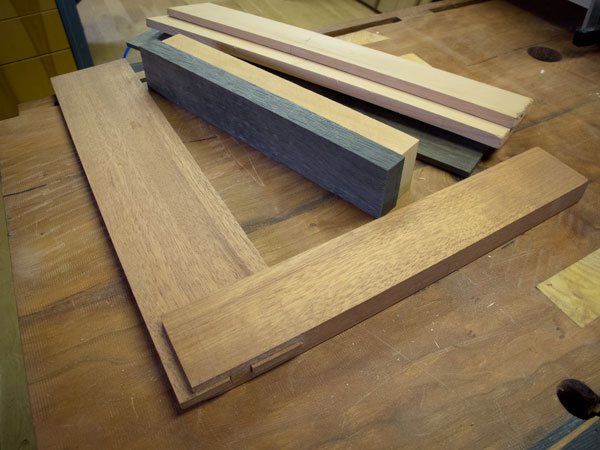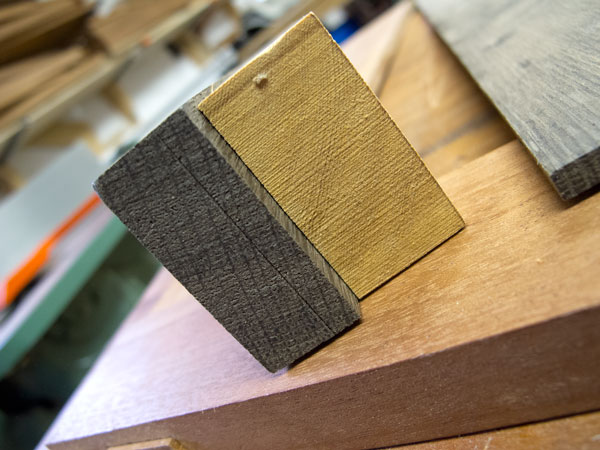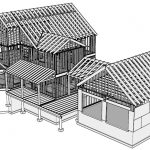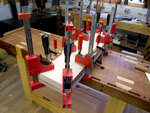We may receive a commission when you use our affiliate links. However, this does not impact our recommendations.
I have lost track of the number of wooden try squares I’ve built in the last five years. At this time last year I had the parts for about 20 mahogany squares in my shop. Now I’m down to one (the rattiest one I couldn’t sell) and some special parts for squares that I don’t want really want to build.
That’s not entirely true; I really want to build them, but I know I’ll end up selling them if I do.
I build two kinds of squares: the one shown in Andre Roubo’s “l’Art du menuisier” (get the plans here), and ones from Benjamin Seaton’s tool chest (buy the book and plans here).
While the French square fetches more “Oooo, pretty” comments, I prefer working at the bench with the Seaton square. I like the chamfers on its stock, and I favor its blade, which tapers slightly in thickness from the stock to the toe.
The woods shown in the photo above are some special pieces I’ve picked up on my travels. They are not exotics, by any means, but they are hard to come by.
The light-colored wood is King Billy Pine (Athrotaxis selaginoides), which I picked up during my trip to Australia last March. It is an amazingly slow-growing pine, like huon pine, that is lightweight, quite strong and fragrant when worked.
Australians said that most of the King Billy they come across has been reclaimed from mines, where it was used as supports. The stock of my King Billy is 1-11/16” wide and took 73 years to grow that amount.
The dark piece of wood is bog oak from Denmark that was given to me by Jonas Jensen during a visit to Germany. Based on the color, the oak is about 5,000 years old and was well on its way to fossilization when it was recovered. This particular oak was also slow-growing – there are more than 50 annular rings in the 1-3/4”-wide stock. It is remarkably lightweight.
I made a set of chisel handles using this oak. They looked beautiful, but they weren’t ideal for striking. After cracking two handles during chopping operations, I put the handles into chisels that are designed for paring (thank you, socket chisels).
So I saved the rest of the bog oak for this try square, which I rarely hit with a mallet.
— Christopher Schwarz
Here are some supplies and tools we find essential in our everyday work around the shop. We may receive a commission from sales referred by our links; however, we have carefully selected these products for their usefulness and quality.











I have a piece of douglas fir that came out of either a telephone pole, or a railroad tie, that would be big enough to resaw for this. It’s very light, and obviously stable. What do you think of using it for a square and/or straight edge?
You cannot make everybody happy!
You know about ” opinions”
Pabloaa
You know what “they” say about opinions??
Great post Chris. I built a small square a while back based on a picture of the Seaton chest. I used some scrap maple and walnut, used a double tenon just like in your picture, and pegged it with wooden pegs. It was a fun and relatively easy project, and I use the small square all the time. Your post reminded me how fun it was, so I think I’ll build another larger one now. Thanks!
Boy, I guess it’s good you didn’t bring up your test nickles. Sounds like mean ol’ mister 7-thumbs would try to break them.
I watched the Woodwright’s Shop episode where you made one of these squares just a few days ago and enjoyed it so much I ordered the Benjamin Seaton book right then. I found a nice looking piece of quarter sawn birch that is big enough for several squares. I got the book today so I think I’ll build some squares this weekend. Thanks for the post. I enjoyed it.
Jim
Chris,
Thanks for sharing your thoughts. I don’t see this article as pointless, and I hope you continue to ignore negative (pointless) comments and share your “ramblings”. I have read your books, built the bench and accessories and my life is better for it! So please, ramble away good sir!!
Another pointless rambling article about nothing by Master Schwarz.